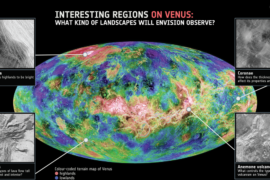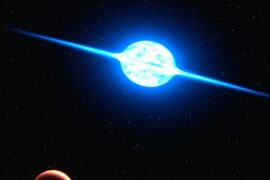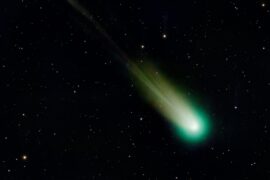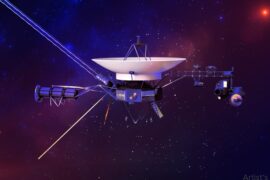What are comets?
Comets are cosmic objects made of rock, ice, dust, and frozen gases. Comets travel around the Sun just like planets do, but unlike planets, they have long, elliptical orbits that take them very close to the Sun.
Comets look interesting to us because of how they look. They seem to leave a long trail of light behind them while they travel. Thanks to this, they can become spectacular shows to watch even when they are relatively small objects compared to other objects in the sky. Comets have a diameter of only a few kilometers and era as big as a small town.
The tail in comets is created when they go near the Sun. The Sun’s light interacts with the ice and gases concentrated in the comet creating an atmosphere around it. The light scattered by this process gives comets their luminous look. Some pieces of dust, ice, and gases in the comet get vaporized and are launched in a stream away from the body of the comet, creating the tail that we see behind them.
When comets are far away from the Sun they are hard to detect as they don’t have a tail, don’t reflect enough light and are too small.
The word comet comes from the Latin word comēta which means “To wear long hair” in reference to the comet’s tail that looks a little bit like strands of hair.
Parts of a comet
Comets are some of the simplest cosmic objects to understand. They are composed only of three main parts that we will explain in detail below.
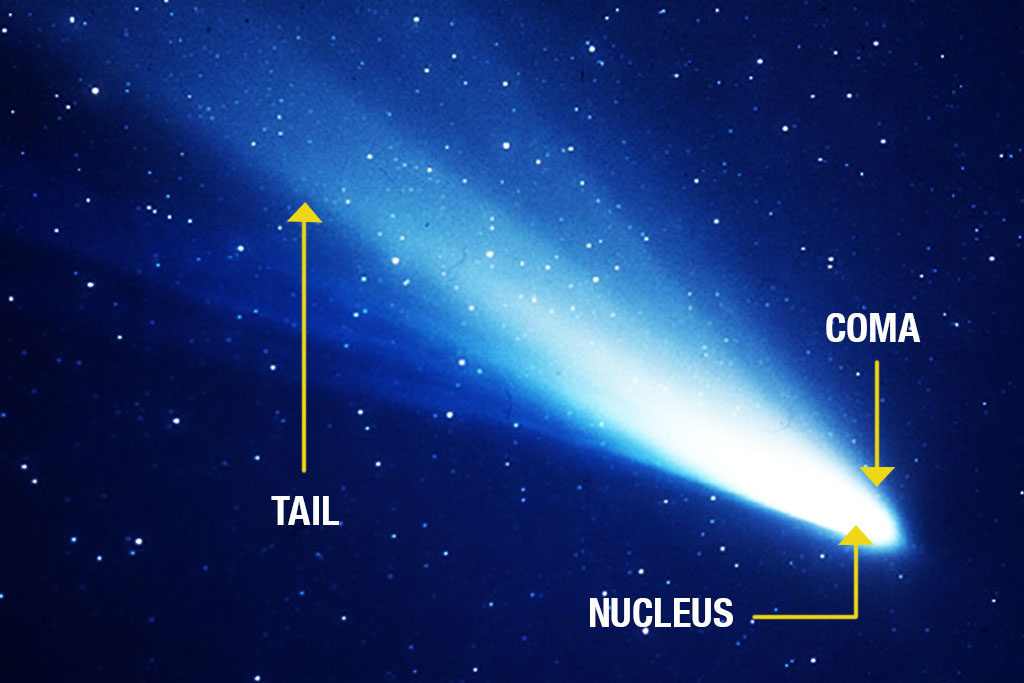
Nucleus – A comet’s nucleus is the solid core of it. It the the rocky, icy part.
Coma – The coma is the thin atmosphere formed around the nucleus. It is created by the gases that are expelled from the core. While the visible part of it is only a bit bigger than the nucleus, the coma can actually extend for thousands of kilometers.
Tail – The tail is the most visually impressive part of the comet. It is the stream of dust and gas that is left behind the comet as it travels and reacts to the Sun’s radiation. The comet’s tail always points away from the Sun.
How big are comets?
Comets vary in size and it is hard to tell exactly how big one is as they tend to have irregular shapes, unlike planets that are mostly circular. The second problem is small comets might become too hard for us to detect.
Usually, smaller comets are between 2 and 15 kilometers (1.8 to 9.3 miles) in diameter, but that is only the main body (nucleus). The tail itself can be as long as 150 million kilometers long (93 million miles). An easier way to remember this is to say comet’s size can be between a football stadium with the parking lot and smaller than Manhattan. The tail can be as long as the distance from Earth to the Sun (which we call 1 Astronomical unit).
How many comets are there?
With our current data, 6,339 comets have been detected and classified, but new comets are being constantly launched and formed.
Where do comets come from?
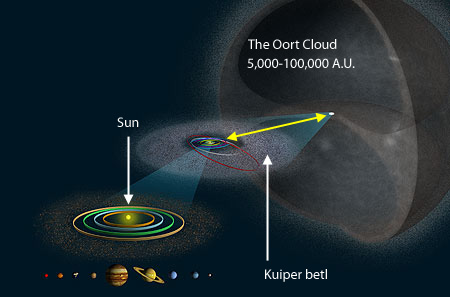
Before we get into where do comets come from we need to explain a couple of groups in our Solar System.
The Kuiper Belt – Also called the Edgeworth–Kuiper belt, it is a ring of rocks made of ice and metal and asteroids just like the asteroid belt, except that The Kuiper Belt is located beyond Neptune and is estimated to be 20 to 200 times larger than the asteroid belt.
The Oort Cloud – Also called the Öpik–Oort cloud, it is a huge cloud of really small icy objects in the outer skirts of the Solar System. The Oort Cloud is estimated to contain billions or even trillions of objects, but it is so far away and the objects are so small that it is hard to get an accurate estimate.
With those terms cleared, now we can get into the two classifications for comets based on how long it takes them to complete their orbit. Short period comets and long-period comets. Short period comets have an orbit of fewer than 200 years while long-period comets take more than 200 years.
It is estimated the short period comets are formed and come from the Kuiper Belt while long-period comets come from the Oort Cloud.
How are comets created?
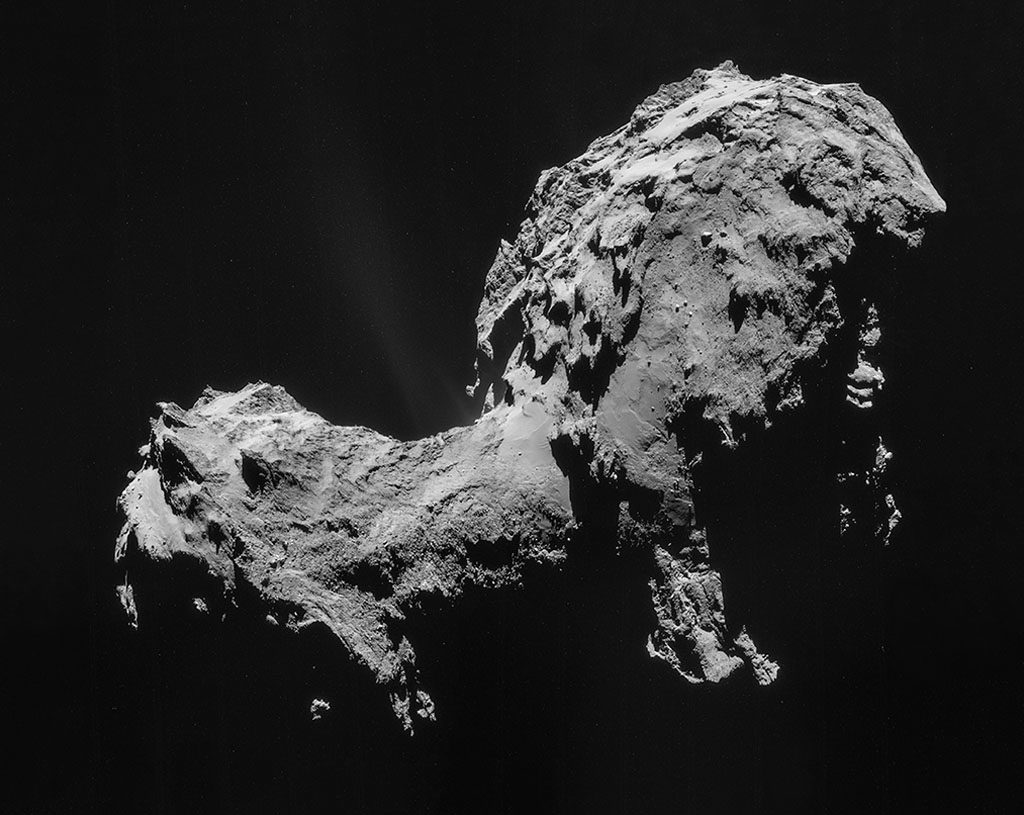
Like many objects in the Solar System, comets are formed from the collision of smaller objects that are attracted to each other thanks to gravity and the randomness of their trajectories.
As mentioned in the section above, comets in the Solar System are formed in the Oort Cloud or the Kuiper Belt where there are trillions of small icy and metallic objects. When these objects clash with one other they form bigger and bigger rocks. Every once in a while, one of these impacts will be powerful enough to impulse one object out of its original orbit and sends it around the Sun in a brand new one.
Types of comets
Comets are so irregular and different one another that classifying them is a difficult task. This has created many categories and classifications for comets that might make things confusing.
For practical purposes, let’s stick to the five main categories of comets.
- Periodic Comets. Also, know as short period comets, have an orbital period of fewer than 200 years. Most periodic comets are hypothesized to be formed in the Kuiper belt. Halley’s comet is a periodic comet with an orbit of 75.3 years.
- Non-periodic comets. Often referred to as long period comets, they have an orbital period longer than 200 years. The Hale–Bopp comet which was visible from Earth with the naked eye for more than 18 months in 1997 is a non-periodic comet. It is believed most of these comets are originated in the Oort Cloud.
- Hyperbolic comets. These are comets with no meaningful orbit. Most of these comets will only orbit the Sun once and then are slingshotted by the Sun’s gravity outside the Solar System. It is believed some of these comets might even be interstellar, meaning they have traveled from other systems.
- Lost comets. These are comets that for some reason or another have been “lost” after their discovery, meaning their fate is unknown.
In 2017 a new letter was added to the international naming convention for comets to separate interstellar comets from the other types, however, the can still be classified as non-periodic or hyperbolic comets.
The complete list of comet types, their sub-types and a list of comets of each type can be found here.
How are comets named?
Some important comets like the Halley and the Hale-Bopp comets are named after the astronomers who discovered them. Naming all of them like this would be difficult and confusing so astronomers have come up with a naming convention.
Comet names mostly look something like D/1977 C1, C/2002 U6 or 1P/-239 K1
The current naming convention has three parts.
The first letter indicates the type of the comet using the following rules:
- P – Periodic comets
- C – Non-periodic comets
- D – Hyperbolic comets
- X – Lost comets
- A – Objects that were mistakenly classified as comets. Only 3 objects have received this classification.
- I – Interstellar comets
The second part of the name is the year the comet was discovered. In some cases, for comets that were discovered a long time ago, a – sign is added to denote the year of discovery is estimated.
The third part of the name is a prefix assigned after the second observed passage of the comet.
The Fate of Comets
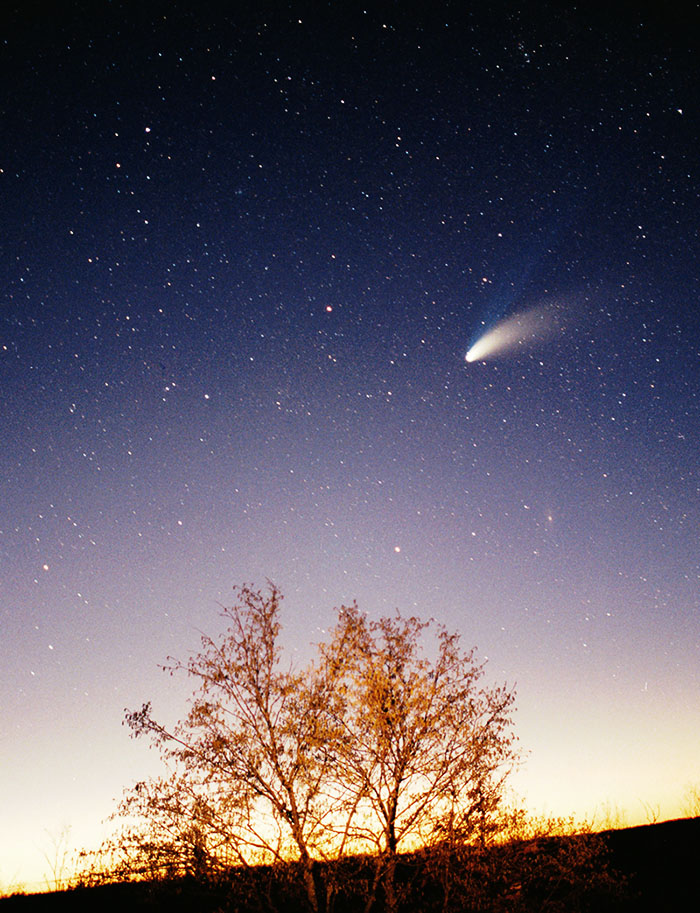
New comets are constantly being created but a lot of them also disappear in one of three different ways.
Fading. You could call this the natural death equivalent of comets. It happens after all the gas and ice in the comet’s nucleus is exhausted after passing close to the Sun many times. Once that happens, all that remains is rock and metals and the comet could now be classified as an asteroid. Short-period comets can survive up to 1,000 orbits around the Sun while most long-period comets fade before completing 50 orbits.
Collisions. Sometimes a comet’s orbit will coincide with a bigger object and crash into it or if it’s a planet with an atmosphere, it can also burn out. Jupiter is famous for having received many comet impacts in the past.
Ejection from the Solar System. If the comet is fast enough, it can be slingshotted when it passes close to a big object like Jupiter or the Sun thanks to their gravity. This sometimes has the effect of ejecting the comet outside the Solar System.
Comets and Meteor Showers
One very cool fact you can learn about comets that most people don’t know is comets are the cause of meteor showers.
Meteor showers are a stream of meteors burning in Earth’s atmosphere at a fast rate during a short period of time. They make for a great light show and are some of the events even people who are not into astronomy enjoy watching.
As comets travel through their orbits, they leave dust and small pieces of rock and ice that split from it. These rocks float in space for a long time. When Earth’s orbit passes through one of these areas, they enter the atmosphere due to Earth’s velocity and gravity. At this point, they burn out in the atmosphere and can now be considered meteors.
Halley’s comet even causes 2 separate meteor showers. The Eta Aquariid meteor shower in May and the Orionids which occurs around October every year.
Are there comets in other solar systems?
Yes. They are called exocomets. Astronomers believe comets are relatively common phenomena, at least in our galaxy, the Milky Way. Ten systems with exocomets have been identified so far but more are being constantly discovered.
Is it possible to see a comet with the naked eye?
Yes, however only one comet can be seen every year on average and they are mostly too small to be an interesting view. Only big, bright comets like the Hale-Bopp comet of 1997 are bright enough to present a show in the night sky.
With the help of a telescope, however, comets can be really fun to watch. If you want to give that a shot, here’s a constantly updated list of comets that can be seen from Earth.
Enjoyed this article?
Get daily 10-minute PDFs about astronomy to read before bed!
Sign up for our upcoming micro-learning service where you will learn something new about space and beyond every day while winding down.




